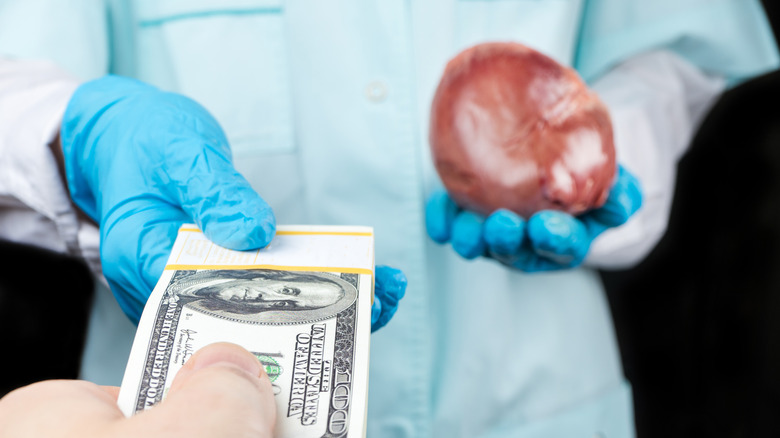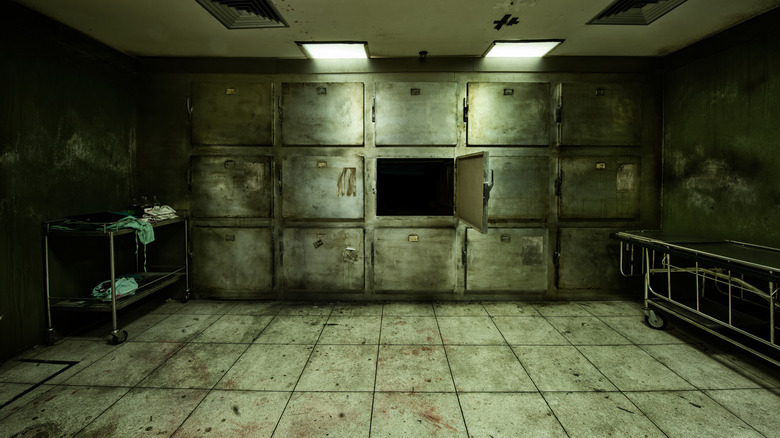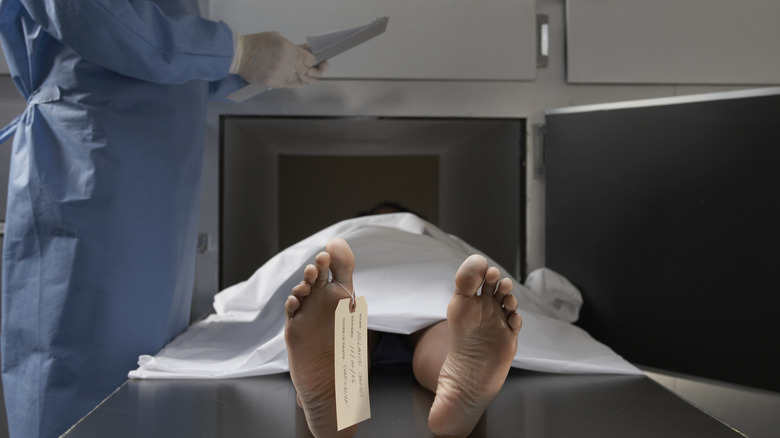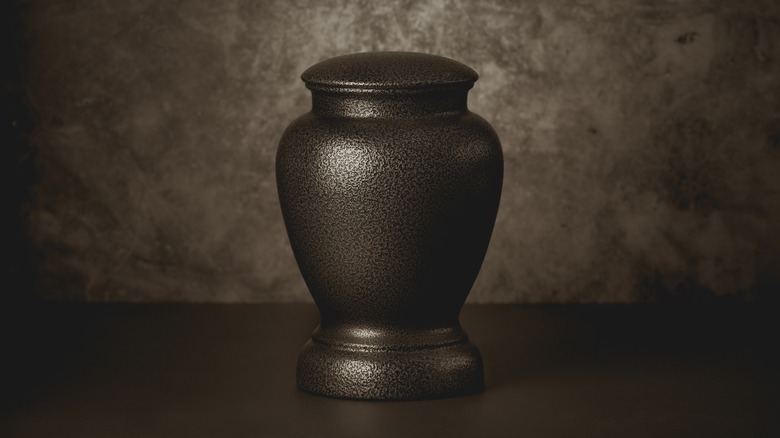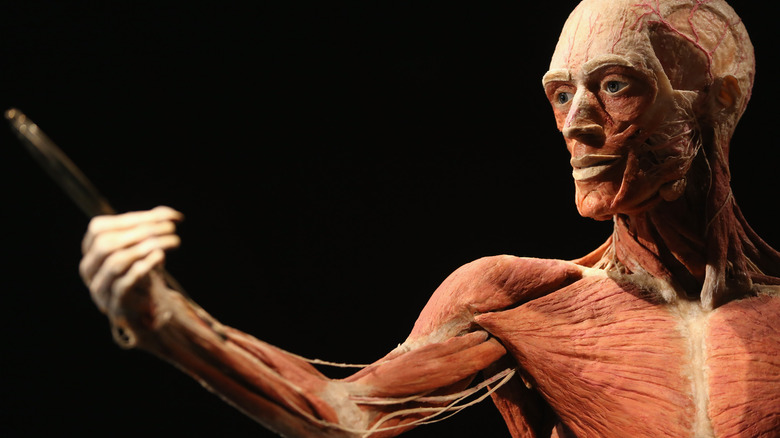The Arizona Company That Sold Cadavers For Military Testing
A lot of people pride themselves on being organ donors, considering it one last good deed they're able to accomplish after they've passed away and no longer need their body and its innards. However, organ donation isn't the only medical or research-related route one can take after death. Body brokering is what happens when a person's body is donated to science. It isn't like organ donation when one's organs are extracted and used for medically necessary transplants for patients in need. When an entire body is donated to science, it can be used for educational purposes and research to expand further what is known about the human condition, according to Reuters.
This may sound perfectly acceptable and even admirable to some. However, one Phoenix, Arizona company unveiled the much darker side of what can happen to bodies when donated. For a period of time, bodies donated to the Biological Resource Center, owned by Stephen Gore, were at risk of being sold to just about anywhere for any purpose, including a Pentagon Improvised Explosive Device (IED) experiment. While people may consent to have their body or the body of a loved one involved in military testing, the body broker industry isn't always transparent about what happens to a body after donation (per The Washington Post).
Body parts sell for a high dollar amount
Seventy-four-year-old Dorris Stauffer's body was donated to the Biological Resource Center after her death in 2013. Her son, Jim, filled out the paperwork and denied consent that his mother's body be used in any sort of non-medical experiments. Contrary to his requests, the body was quickly sold to the U.S. military for blast experiments. The cremated remains Stauffer received were nothing more than his mother's hand, according to Reuters.
The Stauffer family was far from alone in their situation, as the Biological Resource Center was selling dead bodies and body parts without the knowledge of the deceased person's families at an alarming rate. The light regulations on body brokering created an opportunity for companies to make more than a few bucks off the dead. According to Reuters, a human body was sold for $5,893 dollars from the Biological Resource Center. A human torso sold for $3,191 dollars. Gore and his company were profiting handsomely off donated bodies while grieving families remained unaware. The gruesome sales interactions didn't just occur when bodies were healthy, either.
An FBI raid uncovered a scene from a horror movie
In Detroit, Michigan, Delta Airline baggage handlers spotted two coolers that were leaking fluids. The fluids turned out to be blood, and the baggage handlers contacted authorities to open the coolers. Inside were eight severed heads — one of which came from a person who died of bacterial sepsis and aspiration pneumonia, according to The Washington Post.
The address inside the coolers led to another body broker, Arthur Rathburn, who did business with Stephen Gore. This sale of infected body parts led to the FBI raiding Gore's business, or "chop shop," according to The Washington Post. In the raid, the FBI found mountains of body parts without any form of identification. According to ABC Arizona, there were buckets of heads and limbs, along with coolers filled with penises and a torso with the head of a different body sewn on. When people began to discover what was happening to their loved ones, things started to unravel for Gore and the Biological Resource Center.
The Army believed they had consent from the donors and their families
Families began to discover the atrocities at the Biological Resource Center. Some of their loved ones wound up in freezers, some were broken up and sold to multiple facilities across the country, and some were sold to the United States Military for roadside bomb impact testing. According to Reuters, cadavers work better for this form of military testing than regular crash test dummies because crash test dummies don't accurately depict battle wounds caused by explosions. Cadavers allow researchers to witness the damage done to skin, bones, and internal organs. There were 34 bodies involved in the experiment used without donor permission.
The Army requires that consent for the body's inclusion in experiments is obtained. However, the consent forms weren't consistently reviewed or were different from the exact ones filled out by the donor or their loved one. A civilian engineer for the Army, Randy Coates, said in a statement published by Reuters that "The Army was a victim of BRC business practices."
The lack of care and empathy exhibited by the Biological Resource Center and the body broker industry as a whole has left many people to deal with the grieving process as if it's fresh all over again. Some of the victims aren't even sure whether they actually received the ashes of their loved one or the ashes of a stranger's body parts (per AZ Central). However, many believe that Stephen Gore was making a profit off the desperation of those with little money and a lot of despair.
Bodies donated to science are cremated free of charge
Bodies donated to the Biological Resource Center were cremated for free, according to The Washington Post. Free cremation alleviates some of the high costs of dealing with the death of a loved one and often is a reason many consider body donation in the first place. However, even in the form of ashes, receiving scattered bits of remains or remains that aren't even from the person you knew is a nightmare no one wants to face.
Some of the bodies didn't travel far and wound up being used in instructional videos for the Biological Research Center. In a statement published by Reuters, the former assistant chief agent, Charles Loftus, said, "It was like a homemade horror movie," regarding the footage of a video titled "Stripped Cervical Spine!" Ultimately, 10 of the victims' families received $58 million dollars from the Biological Resource Center for the added trauma to an already devastating part of their lives.
There are still good reasons to donate your body to science
Biological Resource Center deceived many and, for a time, got away with profiting off of body parts, both healthy and diseased. While the horrors that took place at the hands of Stephen Gore are atrocious, there are more circumstances in which donating a body to science can actually do more good than harm. Research For Life lists several reasons donating your body to science can have a positive impact, including furthering the education of medical professionals, such as surgeons who continue to practice and develop their techniques throughout their careers. Donated bodies allow these surgeons to get practical experience operating on an actual human cadaver rather than an animal or synthetic material.
At one point, crimes like grave robbing were used to supply cadavers to the medical field for research and education when they were short on bodies (per Smithsonian Magazine). Today, there seems to be a large sum of people willing to donate their bodies to science. So in the case of the Biological Resource Center, selling and disrespecting human bodies while lying to their friends and family was nothing more than a greed-fueled endeavor.

